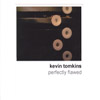Kevin Tomkins, "Perfectly Flawed"
 Kevin Tomkins is probably always going to be known for his tenure in the early (and some would say best) incarnation of Whitehouse, closely followed by his power electronics project Sutcliffe Jugend and the rock-oriented Bodychoke. This first solo outing from him completely defies expectations, being based only on sounds generated by an autoharp.
Kevin Tomkins is probably always going to be known for his tenure in the early (and some would say best) incarnation of Whitehouse, closely followed by his power electronics project Sutcliffe Jugend and the rock-oriented Bodychoke. This first solo outing from him completely defies expectations, being based only on sounds generated by an autoharp.
For such a simple concept, the tracks rarely resemble each other and are based less on the "playing" of the instrument and much more on using every facet of it as a means of generating sound and textures. Only on "Fifth Flaw" and the closing "Twelfth Flaw" is traditional playing the focus, and even within those there is a fair share of abstract clatters and vibrations, the latter being front-loaded with a dense set of sounds, but closing into pure and beautiful tones. "Eighth Flaw" takes the strums and instead messes with the tunings, allowing the loosened strings to rattle and create their own sense of percussion.
The percussive applications of the autoharp are spread throughout the album, sometimes being untreated, but consisting of what must be items bounced on the strings, such as the opening "First Flaw," which adds in extremely quiet swelling tones to balance out. "Ninth Flaw" marries the percussive treatment of the instrument with some Eastern-like string plucks. It is a continuous, collage-like piece that is almost too abstract for its own good, never really locking in to a specific sense of structure or cohesion. The too short "Fourth Flaw" is perhaps the only track where editing and sequencing seems to be a dominant theme, cutting the sounds of plucks and vibrations into a tightly mixed piece that resembles what would be labeled electronica if it was coming out of a laptop or sampler.
The longer "Sixth Flaw" is perhaps the best piece here, and is nicely sequenced right in the center of the album. The layers of autoharp are shaped into insect chatters, tribal percussion elements, and an array of disorienting tones that would make the perfect soundtrack to going up a river into a dark jungle. The following "Seventh Flaw" continues the jungle motif, autoharp being used as a gamelan, and occasionally l ike a fiddle, possibly moving the river metaphor from before out of Africa or Asia and into some of the less settled parts of the American South.
For an album that is focused solely on the use of one instrument, Tomkins has used what sounds more like old fashion experimentation more than technological processing, yet for the most part channels the creaks, groans, and vibrations of an autoharp into diverse and varied compositions. While it lacks the brutality and aggression of his other projects, it retains the structure and composition that set Sutcliffe Jugend apart from many similar noise bands.
samples



